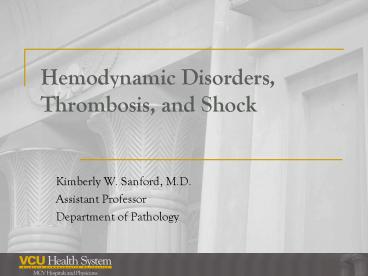Hemodynamic Disorders, Thrombosis, and Shock - PowerPoint PPT Presentation
1 / 76
Title:
Hemodynamic Disorders, Thrombosis, and Shock
Description:
Pulmonary Congestion. Page 20 'Heart Failure Cells' in Alveoli. Page ... Coagulative Necrosis: Pulmonary Infarct. Page 66. Small Intestine Infarction. Page 67 ... – PowerPoint PPT presentation
Number of Views:1780
Avg rating:3.0/5.0
Title: Hemodynamic Disorders, Thrombosis, and Shock
1
Hemodynamic Disorders, Thrombosis, and Shock
- Kimberly W. Sanford, M.D.
- Assistant Professor
- Department of Pathology
2
Edema
- The accumulation of abnormal amounts of fluid in
intercellular spaces or body cavities. - Inflammation and release of mediators (exudate
contains inflammatory cells). - Alterations in hemodynamic forces (transudate
consists of fluid without cells).
3
Lobar Pneumonia with Inflammatory Response
4
Microscopic Pneumonia with Inflammatory Response
5
EdemaHemodynamic Mechanisms
- Increased hydrostatic pressure
- Loss of plasma colloid
- Increased vascular permeability
- Impaired lymphatic drainage
- Salt and water retention
6
Increased Hydrostatic Pressure
- Localized
- Venous stasis
- Ascites
- Generalized
- Cardiac failure
- Renal failure
Hydrostatic pressure
7
Dilated Heart Congestive Failure
8
Left Ventricular Hypertrophy
9
Alveoar Spaces and Bronchiole
10
Pulmonary Edema
11
Fluid Droplets in Trachea/Bronchi
12
Pitting Edema
13
Surface of Cirrhotic Liver
14
Abdominal Ascites
15
Normal Brain
16
Edematous Brain
17
Hyperemia and Congestion
- An increased volume of blood in an affected
tissue or part - Hyperemia active process
- Congestion passive process
18
Congested Lungs
19
Pulmonary Congestion
20
Heart Failure Cells in Alveoli
21
Hemosiderin
22
Congested and Enlarged Spleen
23
Hemorrhage
- Rupture of blood vessels with loss of blood
- Acute
- Chronic (compensatory mechanisms)
24
Berry Aneurysms in Circle of Willis
25
Subarachnoid Hemorrhage
26
Intracerebral Hemorrhage
27
Pericardial Hemorrhage
28
Ruptured Spleen
29
Hemostasis
- Normal hemostatic mechanisms that maintain the
fluidity of the blood and yet allow the rapid
formation of a solid plug to close a defect in a
vascular channel.
30
Thrombosis
- A pathologic process that denotes the formation
of a clotted mass of blood within a
non-interrupted vascular system.
31
Hemostasis and ThrombosisDependent on Three
Factors
- Vascular endothelium
- Platelets
- Coagulation system
32
Endothelial CellsAntithrombotic Properties
- Antiplatelet effects
- Anticoagulant properties
- Fibrinolytic properties
33
Endothelial CellsProthrombotic Properties
- Adhesion of platelets
- Synthesis of von Willebrands factor (VWF)
- Synthesis of tissue factor (TF)
34
Platelets
- Recognize sites of endothelial injury
- Adhere to subendothelial collagen and become
activated - Release chemicals stored within granules (ADP,
Thromboxane A2) - These molecules recruit additional platelets
(primary hemostasis)
35
Coagulation Cascade
- Release of tissue factor from injured endothelial
cells initiates coagulation cascade. - Ultimately forms a more stable plug (secondary
hemostasis).
36
(No Transcript)
37
Anticoagulants
- Antithrombins inhibit serine protease factors
- Proteins C and S inactivate factors Va and VIIIa
- Plasminogen-plasmin system results in fibrinolysis
38
Thrombus
- A mass of blood constituents, platelets, red
cells, fibrin, and white cells formed in the
circulating blood stream
39
ThrombosisPredisposing Factors
- Endothelial injury
- Alterations to normal blood flow
- Hypercoagulability states (Stasis of blood flow)
40
Thrombi Arterial
- Often attached to an atherosclerotic lesion
- Most occur in coronary, cerebral, and femoral
arteries. - Occlusive and alter blood flow
41
Mural Thrombus
42
Coronary Artery Occlusion
43
Abdominal Aortic Aneurysm Thrombus
44
ThrombusPotential Sequelae
- Propagate
- Embolize
- Dissolve
- Recanalize
45
Thrombi Venous
- Occlusive cast of the vessel
- 90 in veins of lower extremities
- Femoral
- Popliteal
- Iliac
46
Deep Vein Thrombosis (DVT)
47
Plaque with Recent Thrombus
48
Thrombus in Vessel Lines of Zahn
49
Early Organizing Thrombus
50
Embolus
- A detached solid, liquid, or gaseous mass that is
carried by the blood stream to a site distal from
its point of origin.
51
Emboli
- 90 originate from thrombi
- Either arterial or venous
- Arterial 85 arise from heart
- Venous Majority arise from leg veins
- Occlude vessels resulting in varying pathology
52
R Ventricle Embolus from Leg Vein
53
Pulmonary Embolus (Saddle)
54
Athero Embolus
55
Tumor Embolus
56
Fat Embolus to Lung
57
Infarct
- An area of ischemic necrosis within a tissue or
an organ that is produced by occlusion of either
its arterial supply or its venous drainage
58
InfarctionEtiologies
- Occlusive thrombi or emboli (99)
- Compromised venous drainage
- Decreased blood flow
59
InfarctionFactors Influencing Development
- Availability of collateral flow or alternate
blood supply - Rate and duration of occlusion
- Susceptibility of tissue to anoxia
- Oxygen content of blood
60
Infarction
- Red (hemorrhagic)
- Venous occlusion
- Loose tissues
- Dual or extensive collateral blood supply
- Pale (anemic)
- Arterial occlusion
- Solid tissues
61
Distal Pulmonary Embolus
62
Pulmonary Infarction
63
Pulmonary Infarction
64
Pulmonary Infarction
65
Coagulative Necrosis Pulmonary Infarct
66
Small Intestine Infarction
67
Pale Infarct (Wedge) of Spleen
68
Kidney Pale Infarct
69
Kidney Infarct, Old
70
Temporal-Frontal Infarct, Old
71
Shock
- Widespread hypoxia of tissues caused by the
ineffective circulation of blood - Hypovolemia
- Impaired cardiac function
- Trauma
- Severe infections
- Generalized hypersensitivity reactions
72
Morphologic Features of Shock
- Brain ischemic encephalopathy
- Heart subendocardial hemorrhages and necrosis
- Kidneys acute tubular necrosis or diffuse
cortical necrosis - Gastrointestinal tract patchy hemorrhages and
necrosis - Liver fatty change or central hemorrhagic
necrosis
73
Kidney Pale Cortex in Shock
74
Ischemic Necrosis of Liver
75
Liver Central Hemorrhagic Necrosis
76
Septic Shock
- High mortality rate (25-50 critically ill)
- Systemic release of endotoxins
- Gram negative bacterial cell walls
- Lipopolysaccharides (LPS)
- Hypotension, dec myocardial contractility,
endothelial injury, disseminated intravascular
coagulation (DIC), fibrinolysis (plasmin) - Bleeding due to consumption of coagulation
factors and activation of fibrinolysis































